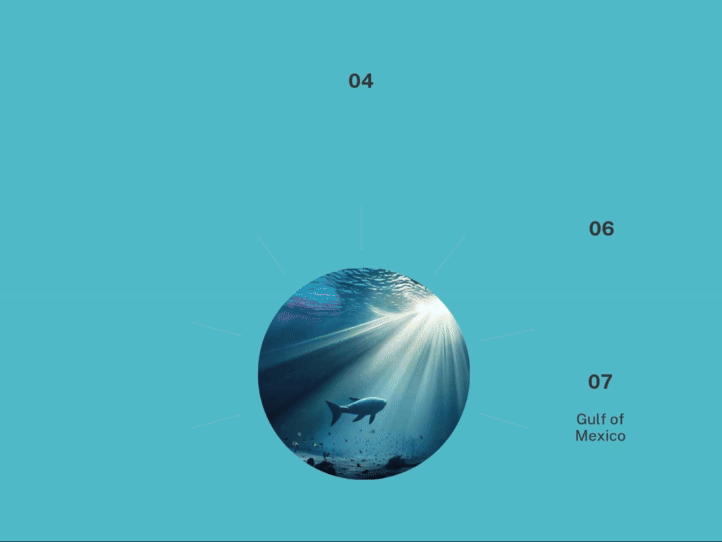Introduction: Top 10 Deepest Oceans in the World
In this article, we set out on a thrilling expedition to reveal the Top 10 Deepest Oceans in the World, illuminating their distinctive qualities, enormous biodiversity, and the scientific discoveries they harbour.
Oceans cover the majority of our world and are home to a remarkable variety of marine life, interesting geological structures, and mysteries that have piqued human curiosity for ages.
“A secret realm of enormous, enigmatic chasms known as deep seas exists under their surface. Come explore the depths with us as we uncover the mysteries of these breathtaking underwater worlds”.

journey to the depths of the abyss with this list of Top 10 Deepest Oceans in the World.
1. The Pacific Ocean – Top 10 Deepest Oceans in the World
The Pacific Ocean, which spans more than 60 million square miles is considered among the top 10 deepest oceans in the world with a depth of 10911m and contains roughly half of the planet’s water, is the world’s biggest and deepest ocean.
From the coast of Asia in the west to the coast of the Americas in the east, it runs from the Arctic in the north to the Southern Ocean in the south.
- The Pacific Ocean is well-known for both its size and the variety of marine life it supports. The Great Barrier Reef, the Marianas Trench, the deepest place on Earth, and the Pacific Ring of Fire, an area renowned for its extreme volcanic and seismic activity, are just a few of its notable characteristics.
- Global climate patterns are significantly influenced by ocean currents, particularly the strong North Pacific Gyre.
- The exploration and history of humanity have both made major use of the Pacific Ocean. It has functioned as a trading route between Oceania, the Americas, and Asia.
Ocean expeditions by prehistoric Polynesian navigators, European explorers like Magellan and Cook, and the Pacific Theatre of World War II have all been recorded.
Even in modern times, the Pacific Ocean is still essential for maintaining marine ecosystems, supplying priceless resources, and acting as an important commerce route. That’s why it will be counted in the Top 10 Deepest Oceans in the World.
2. The Atlantic Ocean
The Atlantic Ocean, which stretches between the Eastern and Western Hemispheres, is among the Top 10 Deepest Oceans in the World with a depth of 8376m.
Europe and Africa border it on the east, while the Americas border it on the west. The Atlantic Ocean, which has a surface size of around 41 million square miles, is essential for international trade, transportation, and climate management.
The history of the Atlantic Ocean has had a big impact on culture, economy, and politics. Throughout history, it has been a crucial path for exploration, colonization, and trade.
Famous occurrences like Christopher Columbus‘ expeditions and the transatlantic slave trade have left enduring marks on the area. The ocean’s diversified marine life, which includes a large variety of fish species, marine animals, and seabirds, is what makes it unique.
The Mid-Atlantic Ridge, a vast underwater mountain range that runs the whole length of the ocean, is also found here. From the chilly waters of the North Atlantic to the warmer seas towards the equator, the Atlantic Ocean undergoes a range of climatic extremes.
It affects the Gulf Stream, an important player in controlling the temperature in Europe, as well as weather patterns and ocean currents.
The Atlantic Ocean, which acts as a passageway between continents and supports a variety of ecosystems and human activities, is a dynamic and significant component of our globe.
3. The Indian Ocean – the top 10 oceans in the world
The Indian Ocean is among the Top 10 Deepest Oceans in the World with a depth of 7258m and is situated between Australia, Asia, and Africa. It is notable for its size and variety of marine life, covering an area of over 27 million square miles.
The Indian Ocean is famous for its strategic significance since it connects the Middle East, Africa, and Asia via an essential commerce route. A wide diversity of marine life, including bright coral reefs, dolphins, whales, and various fish species, may be found in the ocean’s waters.
- Top 10 Deepest Oceans in the World – The lives of coastal populations who depend on fishing and tourism depend heavily on their biodiversity. The monsoon seasons, which affect nations like India and Indonesia, are significantly influenced by the Indian Ocean on regional climates.
- Various climatic phenomena, such as the Indian Ocean Dipole, which affects rainfall patterns, occur there as well. The Indian Ocean has served as a centre for cultural exchange throughout history, bridging civilizations and allowing commerce between ancient empires.
Powerful maritime kingdoms rose and fell there, and it was a key factor in the growth of trade networks like the fabled Silk Road. Nations are vying for access to the Indian Ocean’s resources, commercial routes, and important military locations as it has recently assumed more geopolitical relevance.
International collaboration is necessary to maintain the sustainable management of this essential ocean resource in the face of problems including maritime conflicts, piracy, and environmental concerns.
4. The Southern Ocean – Top 10 Deepest Oceans in the World
The Southern Ocean, commonly referred to as the Antarctic Ocean, is a distinctive body of water that encircles the Antarctic continent. It is among the Top 10 Deepest Oceans in the World with a depth of 7236 m.
It has a surface size of around 20 million square kilometres and is the world’s southernmost ocean. Strong winds, enormous waves, and extremely low temperatures are characteristics of the Southern Ocean.
The Antarctic Circumpolar Current (ACC), which circumnavigates Antarctica in a clockwise direction, is one of the characteristics of the Southern Ocean.
“The ACC, the greatest ocean current in the world, is essential in controlling the climate because it distributes heat and nutrients. A wide variety of marine life, including different types of seals, whales, penguins, and seabirds, may be found in the Southern Ocean.”
Its nutrient-rich waters sustain large concentrations of krill. The Southern Ocean is less studied than other seas because of its isolation and difficult environment.
But for a better knowledge of climate change, ocean circulation patterns, and the delicate ecosystems that survive in this pristine habitat, scientific research in the area is essential.
Through programs like marine protected zones and conservation measures, efforts are being made to safeguard the Southern Ocean and its rare species.
5. The Caribbean – Top 10 Deepest Oceans in the World
The Caribbean islands and the shores of Central and South America surround the Caribbean Sea, a body of water in the Western Hemisphere and one of the Top 10 Deepest Oceans in the World.
It extends across a region of around 2,754,000 square km. The Caribbean Sea is technically not an ocean, but because of its distinct features, it is sometimes recognized as one.
The Caribbean Sea is a well-liked tourist destination, famous for its beautiful blue seas, bright coral reefs, varied marine life, and lovely beaches.
It has a tropical environment with moderate temperatures and calm trade winds all year long, making it the perfect place for a variety of water sports including sailing, snorkelling, and scuba diving.
The Caribbean Sea is home to a variety of marine animals, including colourful fish, sea turtles, dolphins, and coral formations, making it a region rich in biodiversity. It also contributes significantly to the local economy by assisting sectors like fishing, tourism, and transportation.
The Caribbean Sea has also been the scene of important historical occurrences, such as colonial exploration, trade, and piracy during the Age of Sail.
A diversified and lively Caribbean identity has been created as a result of its influences from other cultures and languages. The Caribbean Sea is a spectacular natural wonder that draws tourists from all over the world to its beauty, friendliness, and cultural diversity.
6. The Arctic Ocean
The Arctic Ocean, which has a surface size of around 5.4 million square miles (14 million square kilometres), is the smallest and shallowest ocean in the world. The northern shores of North America and Eurasia encircle this region, which is largely located within the Arctic Circle.
The Arctic Ocean, in contrast to other oceans, is mostly covered by ice, with ice packs and icebergs constituting a sizable portion of its topography. The Arctic Ocean is around 3,953 feet (1,205 meters) deep on average being considered among the Top 10 Deepest Oceans in the World.
Its depth, however, varies greatly, with some regions being shallower due to the existence of continental shelves while others, such as the Eurasian Basin and Canada Basin, reach depths of over 18,000 feet (5,500 meters).
Polar bears, seals, whales, and countless fish species live in the Arctic Ocean, which also plays a significant role in controlling global climate patterns. It also has enormous undiscovered natural resource deposits, including minerals, oil, and gas, which have recently attracted more interest and exploration.
- Due to climate change, the Arctic Ocean is undergoing substantial changes, with declining ice cover and rising temperatures having an influence on its ecosystems and affecting weather patterns worldwide.
- As nations work to utilize their resources and draw marine borders, the region is becoming more and more significant from a geopolitical standpoint. The long-term preservation of this vulnerable environment depends on international collaboration and sustainable management.
7. The Mediterranean – Top 10 Deepest Oceans in the World
The Mediterranean Sea is a large body of water situated between Europe, Africa, and Asia. It is frequently referred to as a sea rather than an ocean. It is linked to the Atlantic Ocean via the Strait of Gibraltar.
The Mediterranean has been an important part of human history for millennia, both as a vital trading route and a centre of cultural exchange.
The Mediterranean Sea has an average depth of around 1,500 meters and is about 2.5 million square kilometres in area and one of the Top 10 Deepest Oceans in the World. It is renowned for having a variety of fish, molluscs, and coral species as well as other marine life.
“Beautiful scenery, sandy beaches, and well-known towns like Barcelona, Rome, Athens, and Istanbul define the sea’s shoreline. With hot, dry summers and warm, rainy winters, the Mediterranean region has a Mediterranean climate”.
The development of civilizations like the Ancient Greeks, Romans, and Phoenicians has been aided by this environment in addition to the region’s rich soil and lengthy history of agriculture.
Millions of travellers go to the Mediterranean Sea each year to enjoy its stunning beaches, vibrant culture, and rich history.
The Mediterranean Sea is still a well-liked tourist destination today. It remains a centre of trade and a meeting place for various civilizations, making it a special and alluring part of the world.
8. The South China Sea – Top 10 Deepest Oceans in the World
The South China Sea is a marginal sea in Southeast Asia that is surrounded by China, Taiwan, Vietnam, the Philippines, Malaysia, and Brunei. It is among the Top 10 Deepest Oceans in the World with a depth of 5016 m.
It has a surface area of over 1.4 million square miles and is renowned for its geopolitical significance and wealth of natural resources. A sizable amount of world trade travels via the waterways of the South China Sea, a vital international maritime route.
It is a valuable economic zone because of its abundance of fisheries, oil and gas reserves, and possible mineral resources. The South China Sea, however, also serves as a flashpoint for territorial conflicts between the neighbouring nations.
- Based on historical claims, China asserts practically complete ownership of the sea, which has sparked hostilities and wars with other countries.
- There are several islands, reefs, and shoals in the South China Sea, some of which have been turned into military outposts by different claims. Concerns about militarization and probable confrontations in the region have been sparked by these developments.
Through diplomatic channels and regional organizations, efforts have been made to settle the disagreements and encourage peaceful coexistence in the South China Sea. Finding a thorough and amicable resolution has been difficult due to the complexity of the conflicting claims and interests.
9. The Bering Sea – Top 10 Deepest Oceans in the World
The Bering Sea is a marginal sea that divides North America from Asia in the Northern Hemisphere. The western coast of Alaska and the furthest east of Russia encircle it. Vitus Bering, a Danish adventurer who visited the region in the 18th century, gave the sea its name.
The Bering Sea, which has a surface area of around 878,000 square miles (2.3 million square kilometres), is renowned for having a rich marine ecology and a variety of fauna and is popular among the Top 10 Deepest Oceans in the World.
Salmon, cod, pollock, and halibut are just a few of the many fish species that call it home and sustain significant commercial and subsistence fisheries.
Intense storms, fog, and sea ice throughout the winter months are some of the extreme weather conditions that the Bering Sea faces. The sea is essential to indigenous societies’ cultural and economic activities.
The Bering Sea was an essential route for early explorers and traders, and it is now a significant region for scientific study and research. The Bering Sea is a mesmerizing and biologically significant region of the planet due to its own ecology and linkages with the Arctic and Pacific Oceans.
10. Gulf of Mexico – Top 10 Deepest Oceans in the World
The Gulf of Mexico is a body of water between northern Mexico and the southeast United States. It extends into the Atlantic Ocean and is around 1.6 million square kilometres in size. It is among the Top 10 Deepest Oceans in the World with a depth of 3787 m.
Warm seas, a variety of marine life, and a large economic impact are all attributes of the Gulf. Indigenous peoples have been living along the Gulf of Mexico’s shore for a very long time before European explorers arrived.
Spanish conquistadors first travelled there in the sixteenth century, and it soon became a vital trading route for European countries.
- The Gulf of Mexico is now well known for its abundant oil and gas resources, which help to sustain a booming offshore energy sector. Additionally, the area is home to thriving fishing grounds where a variety of species, including prawns, oysters, and other kinds of fish, are economically valuable.
- However, the Gulf has had to deal with environmental issues including pollution, the destruction of habitats, and the devastation caused by natural catastrophes like hurricanes.
There are initiatives underway to save and rebuild its ecosystems, such as the maintenance of sensitive coastal wetlands and the use of sustainable fishing methods.
Overall, the Gulf of Mexico is a dynamic and thriving environment that is extremely important to the local economy and ecology.
Conclusion
As a whole, this article highlights the Top 10 Deepest Oceans in the World. The seas of the planet are enormous and enigmatic, containing a universe of extraordinary depth and complexity.
We’ve discovered an amazing variety of geological structures, a wide variety of marine life, and distinctive ecosystems as a result of our research of these deep seas. These depths have scientific significance, but they also provide light on Earth’s past and the ability of life to endure harsh environments.
A tribute to human curiosity, technical improvements, and our undying quest to solve the mysteries that exist below the surface is the exploration of these deep waters.
” It is crucial to strike a balance between scientific research and conservation efforts as we continue to explore and comprehend these deep-sea settings to ensure the long-term preservation of these vulnerable ecosystems.”
We acquire a greater understanding of the astounding diversity and size of our world by casting light on the Top 10 Deepest Oceans in the World. It is a call to protect and respect the priceless riches that these seas offer as well as a reminder of the treasures that lie beneath the waters.
FAQs Top 10 Deepest Oceans in the World
Q1. What ocean reaches the greatest depth on Earth?
- The Mariana Trench, which is located in the Pacific Ocean, is where the Earth’s depths are greatest. The Challenger Deep is home to it, where it descends to a depth of around 36,070 feet (10,972 meters).
Q2. The Mariana Trench is how deep?
- The Mariana Trench, located in the Challenger Deep and measuring roughly 36,070 feet (10,972 meters) deep, is the deepest region of the world’s oceans.
Q3. What ocean is the second in-depth worldwide in the Top 10 Deepest Oceans in the World?
- The Atlantic Ocean ranks second in-depth among all oceans. With a depth of around 28,232 feet (8,605 meters), it is the deepest at that location, which is in the Puerto Rico Trench.
This is a very meaningful article and very much to learn regarding the Top 10 Deepest Oceans in the World.
Sky World










